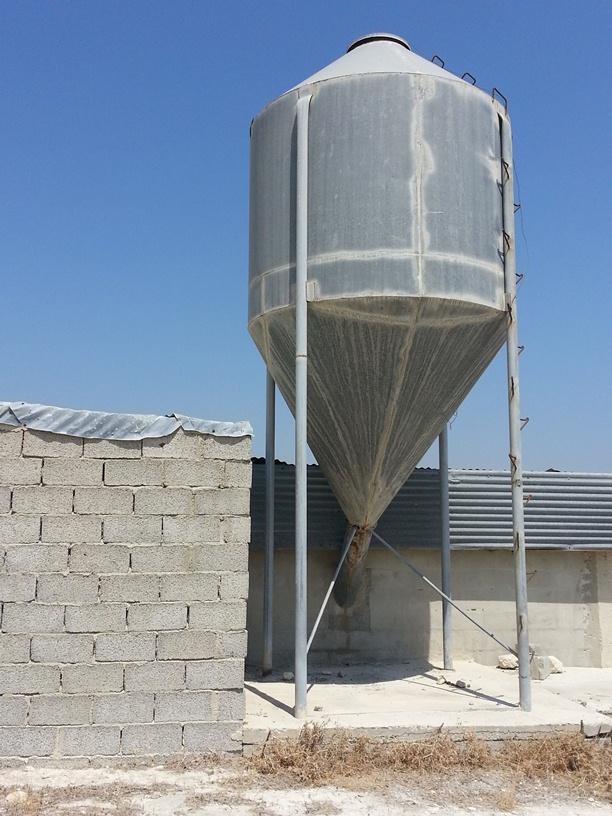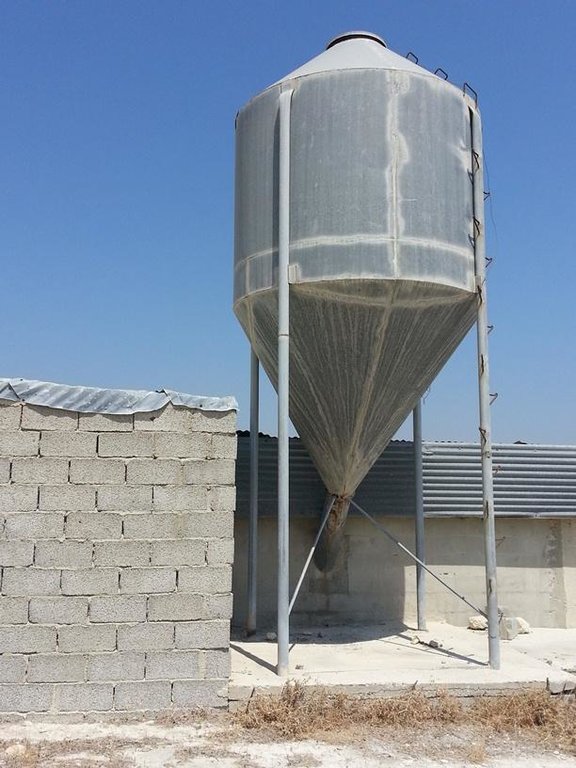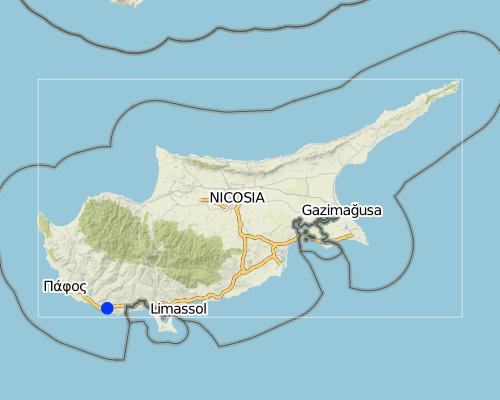Fodder provision to goats and sheep to reduce grazing pressure on natural vegetation [ប្រទេសស៊ីប]
- ការបង្កើត៖
- បច្ចុប្បន្នភាព
- អ្នកចងក្រង៖ Michalakis Christoforou
- អ្នកកែសម្រួល៖ –
- អ្នកត្រួតពិនិត្យ Fabian Ottiger
Παροχή σιτηρεσίου στα αιγοπρόβατα ως εναλλακτική τροφή με σκοπό τη μείωση της υπερβόσκησης στα φυσικά οικοσυστήμα(greek)
technologies_1247 - ប្រទេសស៊ីប
ពិនិត្យមើលគ្រប់ផ្នែក
ពង្រីកមើលទាំងអស់ បង្រួមទាំងអស់1. ព័ត៌មានទូទៅ
1.2 ព័ត៌មានលម្អិតពីបុគ្គលសំខាន់ៗ និងស្ថាប័នដែលចូលរួមក្នុងការវាយតម្លៃ និងចងក្រងឯកសារនៃបច្ចេកទេស
ឈ្មោះគម្រោងដែលបានចងក្រងឯកសារ/ វាយតម្លៃលើបច្ចេកទេស (បើទាក់ទង)
Catastrophic shifts in drylands (EU-CASCADE)ឈ្មោះអង្គភាពមួយ (ច្រើន) ដែលបានចងក្រងឯកសារ/ វាយតម្លៃបច្ចេកទេស (បើទាក់ទង)
Cyprus University of Technology (Cyprus University of Technology) - ប្រទេសស៊ីប1.3 លក្ខខណ្ឌទាក់ទងទៅនឹងការប្រើប្រាស់ទិន្នន័យដែលបានចងក្រងតាមរយៈ វ៉ូខេត
តើពេលណាដែលទិន្នន័យបានចងក្រង (នៅទីវាល)?
15/05/2014
អ្នកចងក្រង និង(បុគ្គលសំខាន់ៗ)យល់ព្រមទទួលយកនូវលក្ខខណ្ឌនានាទាក់ទងទៅនឹងការប្រើប្រាស់ទិន្នន័យដែលបានចងក្រងតាមរយៈវ៉ូខេត:
បាទ/ចា៎
2. ការពណ៌នាពីបច្ចេកទេស SLM
2.1 ការពណ៌នាដោយសង្ខេបពីបច្ចេកទេស
និយមន័យបច្ចេកទេស:
Use of different types of fodder in order to reduce grazing impact on natural vegetation
2.2 ការពណ៌នាលម្អិតពីបច្ចេកទេស
ការពណ៌នា:
Goats graze on almost all plants even on thorny shrubs. The pastoralist in the past (some still do now a days) use to spread seeds on the grazing area in order to provide fodder for the animals. Another method is to provide fodder within the farm using dry seeds of wheat, barley, soya etc which can be stored in big silos.
Purpose of the Technology: The purpose of this technology is to provide to the animals with the food they need in order to minimize or even stop them from grazing on the wild flora such as shrubs, trees and annual plants. Within the study area, most of the vegetation is vanished and only traces of plant species can be found. Even the thorny shrubs like Callicotome villosa and Rhamnus oleiodes are suffering from overgrazing.
Establishment / maintenance activities and inputs: Fodder can be provided in-farm and out-farm. In-farm fodder is provided using a silo in which dry fodder can be store, mixed and deliver to the animals mechanically. Out-farm fodder is provided seasonally since the seeds should be seeded and plants must grow up before eaten by the animals
Natural / human environment: By providing fodder to the animals in-farm, grazing is avoided since the animals remain within the farm. This way, animal diseases transmission from one farm to another can be minimized. Also, animals may travel a long distance to find food whose energy miight be less than the energy they use.
Seeding on the hills will attract the goats and stop them from grazing on other wild plant species. Minimizing grazing will allow to the vegetation to recover and grow up providing good aesthetic view and also shelter for the wild animals. Furthermore, vegetation increase will contribute to the decrease of soil erosion and the increase of organic matter.
2.3 រូបភាពនៃបច្ចេកទេស
2.5 ប្រទេស/តំបន់/ទីតាំងកន្លែង ដែលបច្ចេកទេសត្រូវបានអនុវត្ត និងបានគ្រប់ដណ្តប់ដោយការវាយតម្លៃនេះ
ប្រទេស:
ប្រទេសស៊ីប
តំបន់/រដ្ឋ/ខេត្ត:
Limassol
បញ្ជាក់បន្ថែមពីលក្ខណៈនៃទីតាំង:
Pissouri
Map
×2.6 កាលបរិច្ឆេទនៃការអនុវត្ត
ប្រសិនបើមិនច្បាស់ឆ្នាំ សូមបញ្ជាក់កាលបរិច្ឆេទដែលប្រហាក់ប្រហែល:
- តិចជាង 10ឆ្នាំមុន (ថ្មី)
2.7 ការណែនាំពីបច្ចេកទេស
សូមបញ្ជាក់តើបច្ចេកទេសត្រូវបានណែនាំឱ្យអនុវត្តដោយរបៀបណា:
- តាមរយៈការបង្កើតថ្មីរបស់អ្នកប្រើប្រាស់ដី
មតិយោបល់ (ប្រភេទនៃគម្រោង ។ល។):
EU funding gave the opportunity to some new farmers to buy new equipment for fodder provision. In this way the new farmers were able to feed their animals and increase their productivity
3. ចំណាត់ថ្នាក់នៃបច្ចេកទេស SLM
3.2 ប្រភេទដីប្រើប្រាស់មួយប្រភេទ (ច្រើនប្រភេទ) ដែលបានអនុវត្តបច្ចេកទេស

ដីសម្រាប់ចិញ្ចឹមសត្វ
ដីវាលស្មៅធំៗ:
- ពាក់កណ្តាលពនេចរ
- បែងចែកវាលស្មៅជាប្លុក
ប្រភេទសត្វ និងផលិតផលចម្បងៗ:
Main species semi-nomadism: Goats/rabbits/birds
Main species ranching: Goats
មតិយោបល់:
Major land use problems (compiler’s opinion): overgrazing due to a large amount of animals, drought, erosion
Major land use problems (land users’ perception): drought, poor calcareous soils, incomes are not enough to buy food
Semi-nomadism / pastoralism: goats/ rabbits, birds
Ranching: goats
Future (final) land use (after implementation of SLM Technology): Cropland: Ca: Annual cropping
ប្រសិនបើដីមានការប្រែប្រួលបន្ទាប់ពីការអនុវត្តបច្ចេកទេស សូមបញ្ជាក់ពីការប្រើប្រាស់ដីមុនពេលអនុវត្តន៍បច្ចេកទេស:
Grazing land: Ge: Extensive grazing land
3.3 ព័ត៌មានបន្ថែមអំពីអ្នកប្រើប្រាស់ដី
មតិយោបល់:
Water supply: rainfed, rainfed
ចំនួនសារដែលដាំដំណាំក្នុងមួយឆ្នាំ:
- 2
សូមបញ្ជាក់:
Longest growing period in days: 120Longest growing period from month to month: March to JuneSecond longest growing period in days: 100Second longest growing period from month to month: September to December
ដង់ស៊ីតេនៃសត្វចិញ្ចឹម (បើពាក់ព័ន្ធ):
> 100 LU /km2
3.4 ក្រុម SLM ដែលបច្ចេកទេសស្ថិតនៅក្នុង
- កសិរុក្ខកម្ម (pastoralism) និងការគ្រប់គ្រងដីសម្រាប់ចិញ្ចឹមសត្វ
3.5 ការសាយភាយនៃបច្ចេកទេស
បញ្ជាក់ពីការសាយភាយនៃបច្ចេកទេស:
- ត្រូវបានផ្សព្វផ្សាយត្រឹមតំបន់មួយ
ប្រសិនបើបច្ចេកទេសត្រូវបានសាយភាយពាសពេញតំបន់ណាមួយ សូមកំណត់ទំហំផ្ទៃដីអនុវត្តន៍:
- 10-100 គម2
មតិយោបល់:
The total area in which goat and sheep farmer are allowed to grow animals is around 400 Km2. The area affected by overgrazing is around 100Km2
3.6 វិធានការ SLM ដែលបញ្ចូលនូវបច្ចេកទេស

វិធានការក្សេត្រសាស្ត្រ
- A1: ដំណាំ/គម្របដី

វិធានការរចនាស័ម្ពន្ធ
- S11: ផ្សេងៗ
មតិយោបល់:
Main measures: agronomic measures, structural measures
Specification of other structural measures: Use of Silos in order to provide fodder to the animals
Type of agronomic measures: mixed cropping / intercropping, legume inter-planting
3.7 កំណត់ប្រភេទនៃការធ្លាក់ចុះគុណភាពដីសំខាន់ៗដែលបច្ចេកទេសនេះបានដោះស្រាយ

ការធ្លាក់ចុះជីវសាស្ត្រនៃដី
- Bc: ការថយចុះនូវគម្របរុក្ខជាតិ
មតិយោបល់:
Main type of degradation addressed: Bc: reduction of vegetation cover
Main causes of degradation: overgrazing (large number of animals), change in temperature (hot summers & cold winters force the animals to eat more in order to obtain water and energy from plants), change of seasonal rainfall (summers without rain and winters with some rain), droughts (heavy droughts every 3-4 years), poverty / wealth (farmers can not afford to feed the animals)
Secondary causes of degradation: deforestation / removal of natural vegetation (incl. forest fires) (about 90 years ago), urbanisation and infrastructure development (Urbanisation mostly at the coastal zone has forced the animals to move to the North. A large number of animals is concentrated in the northern site, increasing the overgrazing problem), inputs and infrastructure: (roads, markets, distribution of water points, other, …) (A highway road split the area in two), war and conflicts (In 1974 many refugees moved from the North to the South due to the invasion of Turkish troops. Most of them who established in the area became farmers, and therefore increased the number of animals)
3.8 ការពារ កាត់បន្ថយ ឬស្តារឡើងវិញនៃការធ្លាក់ចុះគុណភាពដី
បញ្ជាក់ពីគោលដៅរបស់បច្ចេកទេស ដែលផ្តោតទៅការធ្លាក់ចុះគុណភាពដី:
- ការកាត់បន្ថយការធ្លាក់ចុះគុណភាពដី
មតិយោបល់:
Main goals: mitigation / reduction of land degradation
4. បច្ចេកទេសជាក់លាក់ សកម្មភាពអនុវត្ត ធាតុចូល និងថ្លៃដើម
4.2 លក្ខណៈពិសេសនៃបច្ចេកទេស/ ពណ៌នាពីគំនូរបច្ចេកទេស
Technical knowledge required for field staff / advisors: high (animal feeding specialist with good knowledge on goat and sheep fodder)
Technical knowledge required for land users: moderate (be able to follow the specialist advice and protocol for feeding animals)
Main technical functions: increase of biomass (quantity), promotion of vegetation species and varieties (quality, eg palatable fodder), control of animal feeding on natural vegetation
Mixed cropping / intercropping
Material/ species: cereal seeds (wheat, barley, etc)
Quantity/ density: 200kg/ha
Remarks: seeds should be seeded by hand during the rainy season
Legume inter-planting
Quantity/ density: 200kg/ha
Remarks: spread the seeds before the last rainfall in spring
Structural measure: Silo
Height of bunds/banks/others (m): 3
Width of bunds/banks/others (m): 1
Construction material (other): stainless steel
Specification of dams/ pans/ ponds: Capacity 9,42m3
4.3 ព័ត៌មានទូទៅដែលពាក់ព័ន្ធនឹងការគណនាធាតុចូល និងថ្លៃដើម
ផ្សេងៗ/ រូបិយប័ណ្ណជាតិ (បញ្ជាក់):
euro
កំណត់អត្រាប្តូរប្រាក់ពីដុល្លាទៅរូបិយប័ណ្ណតំបន់ (បើទាក់ទង)៖ 1 ដុល្លារ =:
0,77
កំណត់ថ្លៃឈ្នួលជាមធ្យមនៃការជួលកម្លាំងពលកម្មក្នុងមួយថ្ងៃ:
38.85
4.4 សកម្មភាពបង្កើត
| សកម្មភាព | ប្រភេទវិធានការ | ពេលវេលា | |
|---|---|---|---|
| 1. | Buy or make a Silo | រចនាសម្ព័ន្ធ | anytime |
| 2. | Buy cereal seeds (200kg) | ក្សេត្រសាស្ត្រ | |
| 3. | Buy legume seeds (200kg) | ក្សេត្រសាស្ត្រ |
មតិយោបល់:
Inputs: Stainless steel
4.5 ថ្លៃដើម និងធាតុចូលដែលត្រូវការសម្រាប់ការបង្កើតបច្ចេកទេស
| បញ្ជាក់ពីធាតុចូល | ឯកតា | បរិមាណ | ថ្លៃដើមក្នុងមួយឯកតា | ថ្លៃធាតុចូលសរុប | % នៃថ្លៃដើមដែលចំណាយដោយអ្នកប្រើប្រាស់ដី | |
|---|---|---|---|---|---|---|
| កម្លាំងពលកម្ម | Labour | ha | 1,0 | 116,0 | 116,0 | 100,0 |
| សម្ភារៈ | Stainless steel silo | ha | 1,0 | 2589,0 | 2589,0 | 100,0 |
| សម្ភារៈ | Fodder transfer tubes | ha | 1,0 | 1000,0 | 1000,0 | 100,0 |
| សម្ភារៈដាំដុះ | Agricultural | ha | 1,0 | 427,0 | 427,0 | 100,0 |
| ថ្លៃដើមសរុបក្នុងការបង្កើតបច្ចេកទេស | 4132,0 | |||||
មតិយោបល់:
Duration of establishment phase: 0.5 month(s)
Life-span of cereal seeds: 6 months
Life-span of legumes seeds: 3-4 months
4.6 សកម្មភាពថែទាំ
| សកម្មភាព | ប្រភេទវិធានការ | ពេលវេលា/ ភាពញឹកញាប់ | |
|---|---|---|---|
| 1. | spreading seeds | ក្សេត្រសាស្ត្រ | during rainfall (oct - Mar) |
4.7 កំណត់ថ្លៃដើមសម្រាប់ការថែទាំ/ សកម្មភាពរបស់បច្ចេកទេស (ក្នុងរយៈពេលមួយឆ្នាំ)
| បញ្ជាក់ពីធាតុចូល | ឯកតា | បរិមាណ | ថ្លៃដើមក្នុងមួយឯកតា | ថ្លៃធាតុចូលសរុប | % នៃថ្លៃដើមដែលចំណាយដោយអ្នកប្រើប្រាស់ដី | |
|---|---|---|---|---|---|---|
| កម្លាំងពលកម្ម | Labour | ha | 1,0 | 233,0 | 233,0 | 100,0 |
| សម្ភារៈដាំដុះ | Seeds | ha | 1,0 | 427,0 | 427,0 | 100,0 |
| ថ្លៃដើមសរុបសម្រាប់ការថែទាំដំណាំតាមបច្ចេកទេស | 660,0 | |||||
មតិយោបល់:
Cost were calculated according to the farmers opinion which was confirmed by the agricultural department. Seeds and labor are calculated as units per ha and the silo per unit (farm)
4.8 កត្តាសំខាន់បំផុតដែលមានឥទ្ធិពលដល់ការចំណាយ
ពណ៌នាពីកត្តាប៉ះពាល់ចម្បងៗទៅលើថ្លៃដើម:
Cost for applying fodder is affected by 3 factors: a) the price of the Silo which is applied only once, b) the cost of the seeds and c) the labor needed for spreading the seeds. The slope in the area where the technology is applied is steep and makes the seeding difficult.
5. លក្ខណៈបរិស្ថានធម្មជាតិ និងមនុស្ស
5.1 អាកាសធាតុ
បរិមាណទឹកភ្លៀងប្រចាំឆ្នាំ
- < 250 មម
- 251-500 មម
- 501-750 មម
- 751-1,000 មម
- 1,001-1,500 មម
- 1,501-2,000 មម
- 2,001-3,000 មម
- 3,001-4,000 មម
- > 4,000 មម
លក្ខណៈពិសេស/ មតិយោបល់លើរដូវភ្លៀង:
Annual rainfall for the year 2013 was 207 mm. From june to october rainfall was 0. In the last three years annual rainfall was between 207 and 540 mm
តំបន់កសិអាកាសធាតុ
- មានភ្លៀងតិចតួច
- ស្ងួត
Thermal climate class: tropics. Winter 0-25 °C, and Summer 20-45 °C
Thermal climate class: subtropics. During the winter, mean temperature can be 15-18 °C
According to the FAO, Cyprus is considered to be an arid to semi-arid area
5.2 សណ្ឋានដី
ជម្រាលជាមធ្យម:
- រាបស្មើ (0-2%)
- ជម្រាលតិចតួច (3-5%)
- មធ្យម (6-10%)
- ជម្រាលខ្ពស់បន្តិច (11-15%)
- ទីទួល (16-30%)
- ទីទួលចោត (31-60%)
- ទីទួលចោតខ្លាំង (>60%)
ទម្រង់ដី:
- ខ្ពង់រាប
- កំពូលភ្នំ
- ជម្រាលភ្នំ
- ជម្រាលទួល
- ជម្រាលជើងភ្នំ
- បាតជ្រលងភ្នំ
តំបន់តាមរយៈកម្ពស់ :
- 0-100 ម
- 101-500 ម
- 501-1,000 ម
- 1,001-1,500 ម
- 1,501-2,000 ម
- 2,001-2,500 ម
- 2,501-3,000 ម
- 3,001-4,000 ម
- > 4,000 ម
មតិយោបល់ និងបញ្ចាក់បន្ថែមអំពីសណ្ឋានដី :
Altitudinal zone: 100-500 m a.s.l (The area where the technology is applied is 1km far from the sea)
Landforms: Hill slopes (The area of interest consists of steep hill slopes)
Slopes on average are rolling (most common) and hilly (sometimes after soil erosion)
5.3 ដី
ជម្រៅដីជាមធ្យម:
- រាក់ខ្លាំង (0-20 សម)
- រាក់ (21-50 សម)
- មធ្យម (51-80 សម)
- ជ្រៅ (81-120 សម)
- ជ្រៅខ្លាំង (> 120 សម)
វាយនភាពដី (ស្រទាប់លើ):
- គ្រើម/ មានពន្លឺ (ខ្សាច់)
សារធាតុសរីរាង្គនៅស្រទាប់ដីខាងលើ:
- មធ្យម (1-3%)
បើអាចសូមភ្ជាប់ការពណ៌នាពីដីឱ្យបានច្បាស់ ឬព័ត៌មានដែលអាចទទួលបាន ឧ. ប្រភេទដី, pH ដី/ ជាតិអាស៊ីត, សមត្ថភាពផ្លាស់ប្តូរកាចុង, វត្តមាននីត្រូសែន, ភាពប្រៃ ។ល។:
Soil depth on average is very shallow (the area is considered to be rocky) to shallow (only where soil is concentrated)
Soil texture is coarse (Analysis has shown that soil texture is 50% sand, 25% silt and 25% Clay)
Soil fertility is low
Topsoil organic matter is medium where some vegetation is, low where no vegetation is and high where vegetation is
Soil drainage/infiltration is poor (inter patch), medium (patch-interpatch) or good (plant patch)
Soil water storage capacity is low-medium
5.4 ទឹកដែលអាចទាញមកប្រើប្រាស់បាន និងគុណភាពទឹក
ទឹកលើដីដែលអាចទាញយកប្រើប្រាស់បាន:
មិនមាន/ គ្មាន
មតិយោបល់ និងលក្ខណៈពិសេសផ្សេងៗទៀតលើគុណភាព និងបរិមាណទឹក :
Availability of surface water is poor/none (there is no surface water available in the area)
5.5 ជីវៈចម្រុះ
ភាពសម្បូរបែបនៃប្រភេទ:
- ទាប
មតិយោបល់ និងលក្ខណៈពិសេសផ្សេងទៀតលើជីវចម្រុះ:
Thorny shrubs, olive and carob trees, annual grass
5.6 លក្ខណៈនៃអ្នកប្រើប្រាស់ដីដែលអនុវត្តបច្ចេកទេស
ចំណូលក្រៅកសិកម្ម:
- 10-50% នៃចំណូល
កម្រិតជីវភាព:
- មិនល្អ
- មធ្យម
ឯកជន ឬក្រុម:
- ធ្វើខ្លួនឯង/ គ្រួសារ
យេនឌ័រ:
- ស្ត្រី
- បុរស
សូមបញ្ជាក់ពីលក្ខណៈពាក់ព័ន្ធផ្សេងទៀតអំពីអ្នកប្រើប្រាស់ដី:
Land users applying the Technology are mainly Leaders / privileged
Difference in the involvement of women and men: no young women are involved with goat farming
Population density: 10-50 persons/km2
Annual population growth: negative
10% of the land users are average wealthy and own 10% of the land (they make profit).
10% of the land users are poor and own 5% of the land (they barely survive).
Off-farm income specification: Some of the pastoralists who apply the SLM technology, have apartments which they rent to tourists during the summer season
Market orientation of production system: Equipment and structure subsidy (50% of the equipment and structures are funded)
Market orientation: Mixed (subsistence and commercial): Pastoralists receive subsidy from EU funds annually
5.7 ទំហំផ្ទៃដីជាមធ្យមនៃដីផ្ទាល់ខ្លួន ឬជួលគេដែលបានអនុវត្តបច្ចេកទេស
- < 0.5 ហិកតា
- 0.5-1 ហិកតា
- 1-2 ហិកតា
- 2-5 ហិកតា
- 5-15 ហិកតា
- 15-50 ហិកតា
- 50-100 ហិកតា
- 100-500 ហិកតា
- 500-1,000 ហិកតា
- 1,000-10,000 ហិកតា
- > 10,000 ហិកតា
តើផ្ទៃដីនេះចាត់ទុកជាទំហំកម្រិតណាដែរ ខ្នាតតូច មធ្យម ឬខ្នាតធំ (ធៀបនឹងបរិបទតំបន់)?
- ខ្នាតធំ
មតិយោបល់:
The animal numbers are 10 times the amount permitted to graze in the area
5.8 ភាពជាម្ចាស់ដី កម្មសិទ្ធប្រើប្រាស់ដី និងកម្មសិទ្ធប្រើប្រាស់ទឹក
ភាពជាម្ចាស់ដី:
- រដ្ឋ
កម្មសិទ្ធិប្រើប្រាស់ដី:
- អាស្រ័យផលសេរី (មិនមានការកំណត់)
- ឯកជន
មតិយោបល់:
More than 70% of the land belongs to the government (forestry department) and the land is open to everybody. The pastoralists do not pay rent for using the land. The land which belongs to individuals is used by the owners or is been rented to the pastoralists
5.9 ការប្រើប្រាស់សេវាកម្ម និងហេដ្ឋារចនាសម្ព័ន្ធ
សុខភាព:
- មិនល្អ
- មធ្យម
- ល្អ
ការអប់រំ:
- មិនល្អ
- មធ្យម
- ល្អ
ជំនួយបច្ចេកទេស:
- មិនល្អ
- មធ្យម
- ល្អ
ការងារ (ឧ. ការងារក្រៅកសិដ្ឋាន):
- មិនល្អ
- មធ្យម
- ល្អ
ទីផ្សារ:
- មិនល្អ
- មធ្យម
- ល្អ
ថាមពល:
- មិនល្អ
- មធ្យម
- ល្អ
ផ្លូវ និងការដឹកជញ្ជូន:
- មិនល្អ
- មធ្យម
- ល្អ
ទឹកផឹក និងអនាម័យ:
- មិនល្អ
- មធ្យម
- ល្អ
សេវាកម្មហិរញ្ញវត្ថុ:
- មិនល្អ
- មធ្យម
- ល្អ
6. ផលប៉ះពាល់ និងការសន្និដ្ឋាន
6.1 ផលប៉ះពាល់ក្នុងបរិវេណអនុវត្តបច្ចេកទេសដែលកើតមាន
ផលប៉ះពាល់លើសេដ្ឋកិច្ចសង្គម
ផលិតផល
ផលិតកម្មចំណីសត្វ
មតិយោបល់/ ការបញ្ជាក់:
Spreading cereals and legumes
ផលិតកម្មសត្វ
មតិយោបល់/ ការបញ្ជាក់:
By providing fodder all year round
ហានិភ័យនៃភាពបរាជ័យរបស់ផលិតកម្ម
មតិយោបល់/ ការបញ្ជាក់:
By providing fodder all year round
ភាពសម្បូរបែបនៃផលិតផល
មតិយោបល់/ ការបញ្ជាក់:
Better quality of dairy products
ការគ្រប់គ្រងដី
ចំណូល និងថ្លៃដើម
ការចំណាយលើធាតុចូលកសិកម្ម
មតិយោបល់/ ការបញ្ជាក់:
During the first year, the cost of the Silo
ចំណូលក្នុងកសិដ្ឋាន
មតិយោបល់/ ការបញ្ជាក់:
Due to production increase
បន្ទុកការងារ
មតិយោបល់/ ការបញ្ជាក់:
In-farm fodder provision. Labor hours are reduced due to the presence of fodder in the silo. Simplified farm operations through using the silo.
ផលប៉ះពាល់ទៅលើវប្បធម៌សង្គម
សន្តិសុខស្បៀង/ ភាពគ្រប់គ្រាន់ខ្លួនឯង
មតិយោបល់/ ការបញ្ជាក់:
Animals from different farms are no more in contact
ចំណេះដឹង SLM / ការធ្លាក់ចុះគុណភាពដី
មតិយោបល់/ ការបញ្ជាក់:
Seeding on the hill reduces erosion
ការកាត់បន្ថយជម្លោះ
មតិយោបល់/ ការបញ្ជាក់:
Between pastoralists
Improved livelihoods and human well-being
មតិយោបល់/ ការបញ្ជាក់:
Shepherds who provide fodder and/or are seeding cereals and legumes on grazing land, produce more milk and meat. Therefore, they have higher incomes and a better life. They are able to send their children to school and provide a health care insurance to their families.
ផលប៉ះពាល់ទៅលើអេកូឡូស៊ី
វដ្តទឹក/លំហូរ
លំហូរទឹកលើផ្ទៃដី
មតិយោបល់/ ការបញ្ជាក់:
Due to vegetation cover
រំហួត
មតិយោបល់/ ការបញ្ជាក់:
Due to vegetation cover
ដី
សំណើមដី
មតិយោបល់/ ការបញ្ជាក់:
Due to vegetation cover
គម្របដី
ការបាត់បង់ដី
មតិយោបល់/ ការបញ្ជាក់:
Due to soil cover by cereals and legumes
ជីវចម្រុះ៖ ដំណាំ, សត្វ
ភាពសម្បូរបែបនៃរុក្ខជាតិ
មតិយោបល់/ ការបញ្ជាក់:
May be in the near future, antagonism between cereals and legumes with other wild type species will appear
ភាពសម្បូរបែបនៃសត្វ
មតិយោបល់/ ការបញ្ជាក់:
Especially birds
6.2 ផលប៉ះពាល់ក្រៅបរិវេណអនុវត្តបច្ចេកទេសដែលកើតមាន
ខូចខាតដល់ស្រែអ្នកជិតខាង
មតិយោបល់/ ការបញ្ជាក់:
On site since the animals will graze in the seeded area
ខូចខាតដល់ហេដ្ឋារចនាសម្ព័ន្ធសាធារណៈ/ឯកជន
មតិយោបល់/ ការបញ្ជាក់:
On site since the animals will graze in the seeded area
6.3 ភាពប្រឈម និងភាពរួសនៃបច្ចេកទេសទៅនឹងការប្រែប្រួលអាកាសធាតុ និងគ្រោះអាកាសធាតុ/ គ្រោះមហន្តរាយ (ដែលដឹងដោយអ្នកប្រើប្រាស់ដី)
ការប្រែប្រួលអាកាសធាតុ
ការប្រែប្រួលអាកាសធាតុ
| រដូវកាល | ប្រភេទនៃការប្រែប្រួលអាកាសធាតុ/ព្រឹត្តិការណ៍ | លក្ខណៈឆ្លើយតបនៃបច្ចេកទេសទៅនឹងការប្រែប្រួលអាកាសធាតុ | |
|---|---|---|---|
| សីតុណ្ហភាពប្រចាំឆ្នាំ | កើនឡើង | មិនល្អ |
គ្រោះអាកាសធាតុ (មហន្តរាយ)
គ្រោះមហន្តរាយធម្មជាតិ
| លក្ខណៈឆ្លើយតបនៃបច្ចេកទេសទៅនឹងការប្រែប្រួលអាកាសធាតុ | |
|---|---|
| ព្យុះភ្លៀងតាមតំបន់ | ល្អ |
| ព្យុះកំបុតត្បូងតាមតំបន់ | មិនស្គាល់ |
គ្រោះមហន្តរាយអាកាសធាតុ
| លក្ខណៈឆ្លើយតបនៃបច្ចេកទេសទៅនឹងការប្រែប្រួលអាកាសធាតុ | |
|---|---|
| រាំងស្ងួត | មិនល្អ |
គ្រោះមហន្តរាយទឹក
| លក្ខណៈឆ្លើយតបនៃបច្ចេកទេសទៅនឹងការប្រែប្រួលអាកាសធាតុ | |
|---|---|
| ទឹកជំនន់ទូទៅ (ទន្លេ) | មិនស្គាល់ |
ផលវិបាកដែលទាក់ទងនឹងបរិយាកាសផ្សេងៗទៀត
ផលវិបាកដែលទាក់ទងនឹងបរិយាកាសផ្សេងៗទៀត
| លក្ខណៈឆ្លើយតបនៃបច្ចេកទេសទៅនឹងការប្រែប្រួលអាកាសធាតុ | |
|---|---|
| កាត់បន្ថយពេលដាំដុះ | មិនស្គាល់ |
6.4 ការវិភាគថ្លៃដើម និងអត្ថប្រយោជន៍
តើផលចំណេញ និងថ្លៃដើមត្រូវបានប្រៀបធៀបគ្នាយ៉ាងដូចម្តេច (ទស្សនៈរបស់អ្នកប្រើប្រាស់ដី)?
រយៈពេលខ្លី:
អវិជ្ជមានខ្លាំង
រយៈពេលវែង:
វិជ្ជមានតិចតួច
តើផលចំណេញ និងការថែទាំ/ ជួសជុលត្រូវបានប្រៀបធៀបគ្នាយ៉ាងដូចម្តេច (ទស្សនៈរបស់អ្នកប្រើប្រាស់ដី)?
រយៈពេលខ្លី:
ប៉ះពាល់តិចតួចបំផុត
រយៈពេលវែង:
វិជ្ជមានតិចតួច
មតិយោបល់:
Shepherds who apply the technology and are in a better socio-economical status are satisfied with their incomes but they believe that things could get better. Shepherds who don't apply the technology are poor, not satisfied with the incomes they receive and at the same time they are negative in applying the technology although they see other shepherds being in a better socio-economic status than them.
6.5 ការទទួលយកបច្ចេកទេស
មតិយោបល់:
100% of land user families have adopted the Technology with external material support
2 land user families have adopted the Technology with external material support
Comments on acceptance with external material support: New farmers-shepherds can have up to 60% funding from EU and government funds for construction and equipment
There is no trend towards spontaneous adoption of the Technology
Comments on adoption trend: The cost of buying fodder is extremely high. Also the equipments (silo) is considered to be expensive.
6.7 ភាពខ្លាំង/ គុណសម្បត្តិ/ ឱកាសនៃបច្ចេកទេស
| ភាពខ្លាំង/ គុណសម្បត្តិ/ ឱកាសនៅកន្លែងរបស់អ្នកប្រើប្រាស់ដី |
|---|
| Using the Silo for providing fodder, they spend less hours in the farm. |
| By providing fodder, the quality and quantity of milk and meat is better |
| By keeping the animals in the farm, they save work hours and also the threat of animal poisoning is minimized |
| ភាពខ្លាំង/ គុណសម្បត្តិ/ ឱកាស ទស្សនៈរបស់បុគ្គលសំខាន់ៗ |
|---|
|
By providing fodder in and out of the farm the animals receive a better quality of fodder and the right quantities of fodder they need. How can they be sustained / enhanced? experts can give advices to the shepherds about the type of fodder, and the quantity during different seasons |
|
Through grazing in a specific area marked and seeded by the shepherd, the animals avoid direct contact with other animals. This minimizes the spread of diseases between animals of different farms. How can they be sustained / enhanced? Shepherds should come to an agreement about the area their animals graze and create borders |
|
Seeding cereals and legumes within the grazing areas decreases overgrazing on shrubs and annual plants How can they be sustained / enhanced? in the case where the shepherd is leading the animals, he should not allow the animals to graze on shrubs |
|
The presence of a Silo in a farm makes fodder provision easier and therefore less work is required How can they be sustained / enhanced? Government funding can cover the cost of the silo |
| seeding in the grazing area leads to improved soil cover which minimizes soil erosion |
6.8 ភាពខ្សោយ/ គុណវិបត្តិ/ ហានិភ័យនៃបច្ចេកទេស និងវិធីសាស្ត្រដោះស្រាយ
| ភាពខ្សោយ/ គុណវិបត្តិ/ ហានិភ័យ ទស្សនៈរបស់អ្នកប្រើប្រាស់ដី | តើបច្ចេកទេសទាំងនោះបានដោះស្រាយបញ្ហាដូចម្តេច? |
|---|---|
| It is difficult to spread seeds on the rocky hills | |
| Buying fodder is expensive |
| ភាពខ្សោយ/ គុណវិបត្តិ/ ហានិភ័យ ទស្សនៈរបស់អ្នកចងក្រងឬបុគ្គលសំខាន់ៗ | តើបច្ចេកទេសទាំងនោះបានដោះស្រាយបញ្ហាដូចម្តេច? |
|---|---|
| Not all shepherd are able to buy the Silo and large amounts of fodder to store in the silo | Government funding can cover the cost of the silo |
| The Randi forest area is suffering from prolonged droughts. Seeding cereals in the grazing land will not be achieved without rain. |
ការតភ្ជាប់ និងម៉ូឌុល
ពង្រីកមើលទាំងអស់ បង្រួមទាំងអស់ការតភ្ជាប់
គ្មានការតភ្ជាប់
ម៉ូឌុល
គ្មានម៉ូឌុល




